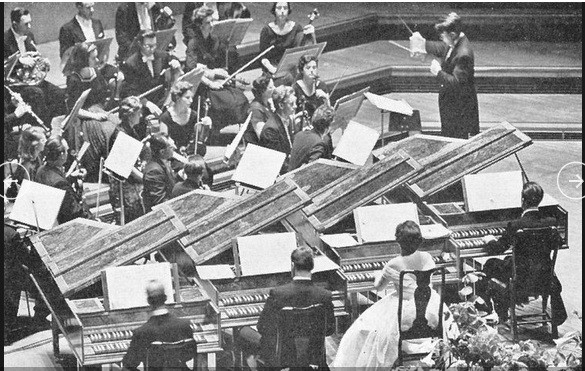James Gardner has made a fascinating oral history programme for Radio New Zealand about Thomas Goff (1898 – 1975), the British lawyer-turned-harpsichord-maker who was related to royalty. Although he made very few instruments, they were highly prized in the 1950s and 60s by the likes of George Malcolm and Thurston Dart, much in demand for concerts, broadcasts, and recordings and were featured in the very popular multi-harpsichord “jamborees” at the Royal Festival Hall.
Please subscribe to this blog – in the top right corner – and receive notifications of new posts by e-mail. In terms of getting information, this is preferable to “liking” the blog (though you can do that too), as Facebook’s money-making system limits the number of people who see our news feed, to as little as 10% of the total sent!
Listen to George Malcolm’s Variations on a Theme of Mozart, for four harpsichords, specially written for these annual RFH concerts, to showcase the broad palette of colours and effects available on the Goff instruments.
According to Jessica Douglas-Home, in her book “Violet”, on the pioneer harpsichordist Violet Gordon Woodhouse, Tom Goff was not just a harpsichord maker:
In spite of all Dolmetsch’s pioneering work, it was still unusual for authentic instruments to be used in concert halls for programmes of seventeenth- or eighteenth-century music. Tom [Goff] was determined to ensure that they should be regarded as an essential part of the proceedings rather than a quaint archaic option. […]
In the cause of his crusade he shamelessly exploited both his musical and his society contacts; and by the 1960s few dared perform eighteenth-century works with solo or continuo keyboard parts other than on a harpsichord.
Until now, very little was known about Thomas Goff’s life, working methods and inspiration, which makes this new research very welcome indeed!
The original Radio New Zealand blurb is reproduced below, by their kind permission:
The Fall and Rise of Harpsichord 6
In August 1956, a beautiful new harpsichord arrived in Wellington aboard the RMS Rangitoto. It had been very recently made by Thomas Goff (1898-1975) of London and before being shipped, it was played by George Malcolm at a concert in the Royal Festival Hall. Goff’s instruments were considered at the time to be “the Steinways of harpsichords”.
Now, it had been purchased by the New Zealand Broadcasting Service for use by the National Orchestra in baroque repertoire and everybody had high hopes for it. It was introduced to the public within a couple of months at a concert in the Wellington Town Hall of Bach’s ‘St Matthew Passion’ [played by Dr Charles Thornton Lofthouse].
The concert was a notorious disaster – no fault of the harpsichord. However, within a few years the instrument fell out of favour and into decline. It sat for decades in the studios of Radio New Zealand, unused and unloved. What went wrong?
James Gardner delves into the colourful and quirky story of Thomas Goff’s Harpsichord No. 6 and of Goff himself. He talks to Peter Averi, retired musician and broadcaster, who was the first person to play the instrument when it was unpacked in Wellington, and to two British harpsichord makers, John Rawson and Peter Owen, who worked with Goff in the 50s and 70s respectively. We also hear the voice of Thomas Goff [in a rare reconstructed radio interview].
But was there a happy ending? The instrument is now owned by Donald Nicolson [who studied with Ton Koopman] and he refers to it affectionately as The Beast. Gardner talks to Nicolson and to instrument technician Paul Downie about the trials and tribulations of trying to get it back into some sort of better-than-reasonable playing condition.
Listen to the complete hour-long programme
Copyright © 2017 Radio New Zealand & Semibrevity – All Rights Reserved


Leave a Reply